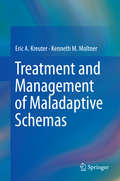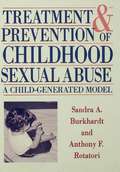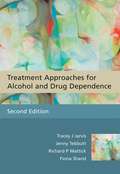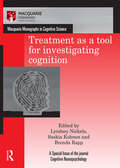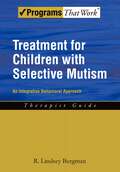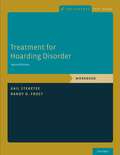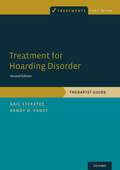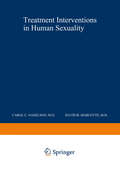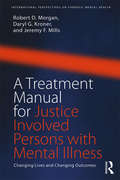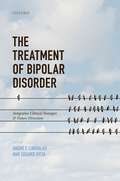- Table View
- List View
Treating Traumatized Children: Risk, Resilience and Recovery
by Danny Brom Ruth Pat-Horenczyk Julian D. FordWhile recent years have seen a vast increase in the literature on adult trauma, interest in childhood trauma has only recently started to gain momentum, encouraging new research and evidence-based interventions. Here the editors have brought together an international list of contributors to look at both innovative and established treatments of trauma in a range of contexts, and provide up-to-date coverage of what is on offer in prevention, assessment, treatment and research. Divided into three parts, main topics discussed are: risk and protective factors for the development of post-traumatic disorders conceptualizations of resilience and suggestions for making them operational evidence-based treatment models for traumatized children Treating Traumatized Children provides professionals with an up-to-date international perspective on the subject, as well as helping professionals and researchers develop future treatments based on current evidence.
Treating Trichotillomania: Cognitive-Behavioral Therapy for Hairpulling and Related Problems (Series in Anxiety and Related Disorders)
by Martin E. Franklin David F. TolinThere is still scant clinical information on trichotillomania. This book fills the need for a full-length cognitive-behavioral treatment manual. The authors share their considerable expertise in treating body-focused repetitive behavior disorders (not only hair-pulling but skin-picking and nail-biting as well) in an accessible, clinically valid reference. This is the first comprehensive, clinical, and empirically-based volume to address these disorders.
Treating Troubled Adolescents: A Family Therapy Approach
by H. Charles FishmanFirst Published in 2017. In the first half of the century therapy for disturbed adolescents focused on individual dynamics or group treatment, and for the most part, did not take into serious consideration adolescents in relation to their families. Adolescent problems were regarded as due mostly to the internal difficulties inherent to the stage of life, and the family was seen mainly as a backdrop to the vicissitudes of personal development. This book, by one of family therapy's most creative practitioners, changes all that. Exclusively devoted to elaborating a family therapy model of understanding and treating adolescents, it is a major contribution to the field. It also performs the unique and much-needed function of revitalizing the concept of homeostasis, moving it from its status as a general explanation for non-change to that of a useful principle for organizing therapeutic dialogue. With exceptional clarity and sensitivity, Charles Fishman shows where and how homeostasis operates in families and how recognizing and working with each family's homeostatic maintainer” can produce significant change. Any clinician who has been ready to give up in frustration when dealing with the thorny problems of adolescent patients will welcome this thoughtful, practical book.
Treating Troubled Adolescents: A Family Therapy Approach
by H. Charles FishmanFirst Published in 2017. In the first half of the century therapy for disturbed adolescents focused on individual dynamics or group treatment, and for the most part, did not take into serious consideration adolescents in relation to their families. Adolescent problems were regarded as due mostly to the internal difficulties inherent to the stage of life, and the family was seen mainly as a backdrop to the vicissitudes of personal development. This book, by one of family therapy's most creative practitioners, changes all that. Exclusively devoted to elaborating a family therapy model of understanding and treating adolescents, it is a major contribution to the field. It also performs the unique and much-needed function of revitalizing the concept of homeostasis, moving it from its status as a general explanation for non-change to that of a useful principle for organizing therapeutic dialogue. With exceptional clarity and sensitivity, Charles Fishman shows where and how homeostasis operates in families and how recognizing and working with each family's homeostatic maintainer” can produce significant change. Any clinician who has been ready to give up in frustration when dealing with the thorny problems of adolescent patients will welcome this thoughtful, practical book.
Treating Vulnerable Populations of Cancer Survivors: A Biopsychosocial Approach
by Tanya R. FitzpatrickThis competence-building resource synthesizes a rich trove of conceptual and practical information on treating cancer survivors at risk of being underserved. Spotlighting a diverse group of ethnic and other demographic populations surviving diverse forms of cancer, the book models the assessing of needs and the developing of strategies to meet them. The multiple burden of cancer—medical and psychosocial problems, discrimination and stigma, quality of life issues—is described in depth as it affects different cultural and age populations. Contributors also present interventions that effectively and meaningfully address these complex intersections of physical, emotional, interpersonal, and layered social concerns.Included among the topics:Providing psychosocial distress screening, coping resources and self-care to newly diagnosed cancer survivors.Latino cancer survivors: the old and the young.An exploration of Latvian immigrants' cancer experience and implications for supportive interventions.Survivorship issues among Muslim women with cancer.How art therapy can benefit the quality of life of young breast cancer survivors.The family caregiver as cancer survivor: supporting and promoting positive bereavement outcomes.Unique among the survivor literature, Treating Vulnerable Populations of Cancer Survivors ably assists health psychologists, social workers, and nurses in providing services to patients facing special challenges during recovery.
Treating Women's Fear of Failure: From Worry to Enlightenment
by Ellen Cole Esther D RothblumThis new book looks at an important issue--the emotional impact of success upon women--at a time when opportunities are more available to them than ever before. Using research, clinical experience, and personal anecdotes, the contributors examine the timely issues of women and worry, women's sense of their own entitlement, fear of success and fear of failure, and women's impostor feelings. The dilemma that feminist therapists frequently experience of encouraging women clients, often superbly qualified in their fields, to take a risk that might involve rejection or failure, is highlighted here. Therapists will recognize the often expressed fears of academic and intellectual failure, as well as the fears of various interpersonal failures that result from a combination of women's opportunities in society as well as socialization.
Treating Women's Fear of Failure: From Worry to Enlightenment
by Ellen Cole Esther D RothblumThis new book looks at an important issue--the emotional impact of success upon women--at a time when opportunities are more available to them than ever before. Using research, clinical experience, and personal anecdotes, the contributors examine the timely issues of women and worry, women's sense of their own entitlement, fear of success and fear of failure, and women's impostor feelings. The dilemma that feminist therapists frequently experience of encouraging women clients, often superbly qualified in their fields, to take a risk that might involve rejection or failure, is highlighted here. Therapists will recognize the often expressed fears of academic and intellectual failure, as well as the fears of various interpersonal failures that result from a combination of women's opportunities in society as well as socialization.
Treating Worker Dissatisfaction During Economic Change (ISSN)
by Ben Robinson Morley D. GlickenIn the current economy, companies are expected to turn on a dime in response to changing market needs to stay vibrant. What that means is that companies are constantly reorganizing. Employees are living in a constant state of change. This dynamic in the workplace has affected worker satisfaction, morale, and burnout. This is the first treatment manual to focus on treating job-related issues, whether it's conflict in the workplace, stress, burnout, performance, and more. Divided into two parts, Part One sets the stage with a discussion of the economic climate and how it impacts businesses, how business reacts to it, and how the new business climate affects employees. Part Two lays out the most current research on effectively treating work-related client issues. Individual, group, and organizational interventions are included, along with case examples, practical treatment exercises, checklists, and outlines for treatment.Summarizes how the changing workplace impacts workersCovers effective ways of treating and preventing worker problemsIncludes case examples of treating common workplace depression, accidents, substance abuse, violence, stress, illness, conflict, and performanceDiscusses individual, group, and organizational interventionsProvides online exercises, checklists, evaluation formats, and outlines for treatmentIntegrates issues of diversity including race, ethnicity, age, and gender
Treating Youth Who Sexually Abuse: An Integrated Multi-Component Approach
by Stephen LundriganA comprehensive program of treatment for adolescent sex offenders! Covering every phase from assessment to relapse prevention, this valuable book offers specific suggestions and backs them with the latest research as well as years of clinical experience. Treating Youth Who Sexually Abuse: An Integrated Multicomponent Approach is a training tool, reference book, and field manual for the use of therapists, administrators, and everyone involved with the assessment, treatment, and placement of sexually abusive youth. Beginning with a broad view of the continuum of programs available and the structure of the service-delivery system that provides treatment, Treating Youth Who Sexually Abuse continues with specifics of program policy and design in both outpatient and inpatient settings. From choice of client to aftercare, the book covers the specifics of pretreatment, various modalities of therapy, inpatient and outpatient programs, and relapse-prevention programs. The foundations of program structure and the specific components (such as family therapy, group therapy, milieu treatment) are integrated to make a powerful, flexible, and above all effective treatment tool. Treating Youth Who Sexually Abuse offers practical advice and help for therapists and administrators, including: ready-to-use treatment materials reproducible group curricula sample schedules for full-day treatment and afterschool programs discussions of staff training and administrative concerns information on liability issues ideas for coordinating care with other treatment providersTreating Youth Who Sexually Abuse: An Integrated Multicomponent Approach is an essential training tool for students, a field manual for professionals, and a reference book for everyone interested in sex offence-specific treatment for youth. With case studies, diagnostic criteria, helpful tables and diagrams, listings of organizations in the field and Web addresses, this volume deserves a permanent place on your professional bookshelf.
Treating Youth Who Sexually Abuse: An Integrated Multi-Component Approach
by Stephen LundriganA comprehensive program of treatment for adolescent sex offenders! Covering every phase from assessment to relapse prevention, this valuable book offers specific suggestions and backs them with the latest research as well as years of clinical experience. Treating Youth Who Sexually Abuse: An Integrated Multicomponent Approach is a training tool, reference book, and field manual for the use of therapists, administrators, and everyone involved with the assessment, treatment, and placement of sexually abusive youth. Beginning with a broad view of the continuum of programs available and the structure of the service-delivery system that provides treatment, Treating Youth Who Sexually Abuse continues with specifics of program policy and design in both outpatient and inpatient settings. From choice of client to aftercare, the book covers the specifics of pretreatment, various modalities of therapy, inpatient and outpatient programs, and relapse-prevention programs. The foundations of program structure and the specific components (such as family therapy, group therapy, milieu treatment) are integrated to make a powerful, flexible, and above all effective treatment tool. Treating Youth Who Sexually Abuse offers practical advice and help for therapists and administrators, including: ready-to-use treatment materials reproducible group curricula sample schedules for full-day treatment and afterschool programs discussions of staff training and administrative concerns information on liability issues ideas for coordinating care with other treatment providersTreating Youth Who Sexually Abuse: An Integrated Multicomponent Approach is an essential training tool for students, a field manual for professionals, and a reference book for everyone interested in sex offence-specific treatment for youth. With case studies, diagnostic criteria, helpful tables and diagrams, listings of organizations in the field and Web addresses, this volume deserves a permanent place on your professional bookshelf.
Treatment and Management of Maladaptive Schemas
by Eric A. Kreuter Kenneth M. MoltnerThis volume explores new ground in the area of personal transformation, achieved partly through a person’s volition with a guide or catalyst. The authors research and define the dynamics of paradigmatic-thinking, incorporating a series of case vignettes of personal transitions. They describe impediments to such change, as well as the post-transformation state of mind where vulnerabilities may persist. The resultant need for on going commitment may include guidance or coaching in order to sustain the positive effect of a change in paradigm. An important feature of the book is a case study written by “Rex,” a participant in Dr. Kreuter’s earlier work. Rex has achieved significant change in his thought process, both in how he sees the world (less sinister) and his self-perspective (worthy and connected). An in-depth view of the “new” Rex shows the extent to which change has been possible in one human being. Combined with other evidence of shifting paradigms drawn from a cross-section of therapeutic practice, the authors connect the clinical data with their own developed philosophy on the subject of human behavior and the ability to change with the assistance of a therapist guide to effectuate and sustain such change.
Treatment And Prevention Of Childhood Sexual Abuse
by Sandra A. Burkhardt Anthony F. RotatoriFirst published in 1995. Routledge is an imprint of Taylor & Francis, an informa company.
Treatment And Prevention Of Childhood Sexual Abuse
by Sandra A. Burkhardt Anthony F. RotatoriFirst published in 1995. Routledge is an imprint of Taylor & Francis, an informa company.
Treatment Approaches for Alcohol and Drug Dependence: An Introductory Guide
by Tracey J. Jarvis Jenny Tebbutt Richard P. Mattick Fiona ShandThe first edition of this book was based upon the recommendations of the Quality Assurance in the Treatment of Drug Dependence Project, and provided a step-by-step-guide for therapists working with clients with alcohol or other drug dependency or misuse. Since publication in 1995 it has become well known for its easy-to-read style and wealth of practical resource materials. However, the evidence in the field has moved forward in the last eight years, creating a need for an updated edition. Retaining the trademark easy-to-use, up-to-date style, the Second Edition offers new chapters on pharmacotherapies, case management, young people, and dual diagnosis. Other chapters have been updated to reflect the latest research findings and current practice, and the practice sheets and client handouts are made available online for downloading and customization by therapists.
Treatment as a tool for investigating cognition (Macquarie Monographs in Cognitive Science)
by Lyndsey Nickels, Saskia Kohnen and Brenda RappCognitive neuropsychological research studies of people with cognitive deficits have typically been directed either at investigating methods of intervention, or at furthering our understanding of normal and impaired cognition. This book reports on research that combines these goals, using studies that use intervention as a ‘tool’ for investigating hypotheses about the functioning of the human cognitive system. The introductory chapter discusses some of the unique and more general difficulties that this approach faces, while the five reports describe intervention studies with children and adults with cognitive impairments – studies which investigate current theories of cognition. The studies demonstrate that the use of intervention to study cognition is a promising and valuable methodology. Aiming to promote wider use of these combined methods, this book makes it clear that while the approach faces various methodological and interpretative challenges, it has the advantage of providing advances on issues of theory while, at the same time providing treatment to participants, and bringing together what have been largely separate research traditions. This book was originally published as a special issue of Cognitive Neuropsychology.
Treatment as a tool for investigating cognition (Macquarie Monographs in Cognitive Science)
by Lyndsey Nickels Saskia Kohnen Brenda RappCognitive neuropsychological research studies of people with cognitive deficits have typically been directed either at investigating methods of intervention, or at furthering our understanding of normal and impaired cognition. This book reports on research that combines these goals, using studies that use intervention as a ‘tool’ for investigating hypotheses about the functioning of the human cognitive system. The introductory chapter discusses some of the unique and more general difficulties that this approach faces, while the five reports describe intervention studies with children and adults with cognitive impairments – studies which investigate current theories of cognition. The studies demonstrate that the use of intervention to study cognition is a promising and valuable methodology. Aiming to promote wider use of these combined methods, this book makes it clear that while the approach faces various methodological and interpretative challenges, it has the advantage of providing advances on issues of theory while, at the same time providing treatment to participants, and bringing together what have been largely separate research traditions. This book was originally published as a special issue of Cognitive Neuropsychology.
Treatment for Children with Selective Mutism: An Integrative Behavioral Approach (Programs That Work)
by R. Lindsey BergmanSelective Mutism (SM) is an impairing behavioral condition in which a child fails to speak in certain social situations despite speaking regularly and normally in other situations. SM presents a significant mental and public health problem due to impact on the social, emotional, and academic functioning of young children at a critical point in their development. SM is closely related to childhood social phobia, but it cannot be treated in the same way because of the young age of the children affected, their lack of speech in the treatment setting, and the need for significant school involvement in treatment. Treatment for Children with Selective Mutism outlines the sequence and essential elements to guide clinicians through a comprehensive, integrated program for young children who display symptoms of SM. This approach utilizes behavioral interventions targeting gradual increases in speaking across settings in which the child initially has difficulty. The integrated nature of the therapy refers to the goal of incorporating input from the clinician with that from the parents and teacher, as well as others impacted by the lack of speech. Exposure exercises are based on behavioral techniques such as stimulus fading, shaping, and systematic desensitization that also allow for a less intense or gradual exposure to the speaking situation. These techniques are combined and used flexibly with a behavioral reward system for participation in treatment. The approach was developed by Dr. R. Lindsey Bergman as part of the UCLA Childhood OCD, Anxiety, and Tic Disorders Program. The treatment protocol consists of 20 sessions, 60 minutes each, delivered over the course of 24 weeks. Treatment for Children with Selective Mutism is an invaluable guide for mental health professionals who deliver CBT-based treatment to children and want to help those with SM.
Treatment for Hoarding Disorder: Workbook (Treatments That Work)
by Gail Steketee Randy O. FrostThe relationship people have with their possessions ranges from purely utilitarian to intensely emotional. For most people, their personal possessions provide them with a sense of security, comfort, and pleasure. However, if someone loses the ability to distinguish useful or important possessions from those that make life overly complicated, the objects can become a prison. For people who suffer from Hoarding Disorder (HD), the process of getting rid of unneeded objects is not easy. For them, possessions never "feel" unneeded and trying to get rid of them is an excruciating emotional ordeal. This Second Edition of Treatment for Hoarding Disorder is the culmination of more than 20 years of research on understanding hoarding and building an effective intervention to address its myriad components. Thoroughly updated and reflective of changes made to the Fifth Edition of the Diagnostic and Statistical Manual for Mental Disorders (DSM-5), this second edition of the client Workbook and accompanying Therapist Guide outlines an empirically supported and effective CBT program for treating hoarding disorder. This Workbook is meant to guide clients through their treatment for hoarding disorder with their clinician. It includes homework, forms, exercises, and behavioral experiments for clients to test their personal beliefs about possessions, develop an organization plan and filing system, and sort and organize items room by room. A major goal of the treatment is to recapture the positive role of possessions in the lives of people with hoarding problems, and strategies are outlined for sustaining gains and making further progress, as well as for managing stressful life events that can provoke problematic acquiring and difficulty discarding.
Treatment for Hoarding Disorder: Therapist Guide (Treatments That Work)
by Gail Steketee Randy O. FrostThe relationship people have with their possessions ranges from purely utilitarian to intensely emotional. For most people, their personal possessions provide them with a sense of security, comfort, and pleasure. However, if someone loses the ability to distinguish useful or important possessions from those that make life overly complicated, the objects can become a prison. For people who suffer from Hoarding Disorder (HD), the process of getting rid of unneeded objects is not easy. For them, possessions never "feel" unneeded and trying to get rid of them is an excruciating emotional ordeal. This Second Edition of Treatment for Hoarding Disorder is the culmination of more than 20 years of research on understanding hoarding and building an effective intervention to address its myriad components. Thoroughly updated and reflective of changes made to the Fifth Edition of the Diagnostic and Statistical Manual for Mental Disorders (DSM-5), this second edition of the Therapist Guide and accompanying client Workbook outlines an empirically supported and effective CBT program for treating hoarding disorder. This Therapist Guide is written for mental health clinicians-psychologists, social workers, psychiatrists, counselors, and psychiatric nurses-to guide effective treatment of people with hoarding disorder. It provides numerous assessment and intervention forms to help clients use the methods described in the intervention. A major goal of the treatment is to recapture the positive role of possessions in the lives of people with hoarding problems, and strategies are outlined for sustaining gains and making further progress, as well as for managing stressful life events that can provoke problematic acquiring and difficulty discarding.
Treatment Interventions in Human Sexuality (Critical Issues in Psychiatry)
by Carol C. Nadelson and David B. MarcotteDespite much progress in the past ten years, American medical schools have woefully inadequate sex education curricula. While some have a reasonable amount of lecture time, few have clinical opportunities for students to develop practical skills in working with patients who are struggling with sexual problems. It is my impression that the same is true in medical and gynecological residencies, as well as in graduate schools of psychology, counseling and social work. This book was specifically written to help fill that gap. This is a book for clinicians, and it will provide a wealth of practical clinical knowledge and skills in dealing with the gamut of patient's sexual concerns, problems and dilemmas. Twenty-four experts have contributed eighteen chapters which address both the common and unusual sexual issues encountered in practice. These include sexual concerns from childhood to old age; gender identity and sexual preference; sexual dysfunction, including that of the physically ill and disabled; counseling with students, premarital, marital, and divorced patients; fertility and infertility; and chap ters dealing with rape, incest and other sexual contacts between adults and children. Of particular importance are chapters on human sexuality in American minority popula tions, a chapter on alcohol, medication and other drugs, and a chapter on medical management of sexual problems in the gay population, a subject long-ignored by the profession. The focus on practical intervention and skill development is amplified by the concluding four appendixes devoted to patient management problems.
A Treatment Manual for Adolescents Displaying Harmful Sexual Behaviour: Change for Good (PDF)
by Eamon Mccrory Paula Walker-RhymesA Treatment Manual for Adolescents Displaying Harmful Sexual Behaviour is a resource for clinicians working therapeutically with male adolescents who have shown harmful sexual behaviour (HSB). Comprised of a printed manual and a CD-ROM, it is designed to be delivered over 30 sessions across 4 modules, but can be adapted to suit the needs of individual adolescents. The four modules address a range of clinical tasks, including: establishing rapport and a therapeutic alliance with the young person; developing the relationship skills of the young person and addressing their harmful sexual behaviour; the young person's feelings, thoughts and beliefs and developing their capacity to regulate emotions and sexual arousal; and issues of sexuality, dating, endings and relapse prevention. The printed manual outlines the background that any clinician delivering treatment needs to consider, including a description of key therapeutic techniques, practical advice on how to prepare for and deliver an intervention, overviews of the modules and sessions, and sample session plans. Each session plan is clearly written in a step-by-step format and is stored electronically on the CD-ROM so they can be easily printed as often as required. The CD-ROM also contains 'Home Project' sheets (homework tasks to consolidate the in-session therapeutic work) as well as a specially commissioned 'Character Library' with cut-out figures and background scenes that can be used as tools for the young person to explore real and fictional scenarios. This professional resource aims to provide the clinician with the tools to address adolescent harmful sexual behaviour within a broader social and emotional developmental context, and will aid those working with young people to motivate them to engage in a positive process of change.
A Treatment Manual for Justice Involved Persons with Mental Illness: Changing Lives and Changing Outcomes (International Perspectives on Forensic Mental Health)
by Daryl Kroner Robert D. Morgan Jeremy F. MillsPlease click on the Companion Website link above or visit www.routledge.com/cw/morgan to access the companion workbook, Changing Lives, Changing Outcomes: A Treatment Program for Justice-Involved Persons with Mental Illness. A Treatment Manual for Justice Involved Persons with Mental Illness comprises a comprehensive and structured treatment manual that provides clinicians a guide for treating justice involved persons with mental illness. The manual includes a treatment plan for each session with specific structured exercises (for both in-group and out of group work) designed to teach objectives each session. The program incorporates a psychosocial rehabilitation model, social learning paradigm and cognitive-behavioral model for change, although cognitive behavioral theory is more prevalent and apparent throughout the manual. Additional training on Changing Lives and Changing Outcomes: A Treatment Program for Justice-Involved Persons with Mental Illness is available at https://www.gifrinc.com/clco.
A Treatment Manual for Justice Involved Persons with Mental Illness: Changing Lives and Changing Outcomes (International Perspectives on Forensic Mental Health)
by Daryl Kroner Robert D. Morgan Jeremy F. MillsPlease click on the Companion Website link above or visit www.routledge.com/cw/morgan to access the companion workbook, Changing Lives, Changing Outcomes: A Treatment Program for Justice-Involved Persons with Mental Illness. A Treatment Manual for Justice Involved Persons with Mental Illness comprises a comprehensive and structured treatment manual that provides clinicians a guide for treating justice involved persons with mental illness. The manual includes a treatment plan for each session with specific structured exercises (for both in-group and out of group work) designed to teach objectives each session. The program incorporates a psychosocial rehabilitation model, social learning paradigm and cognitive-behavioral model for change, although cognitive behavioral theory is more prevalent and apparent throughout the manual. Additional training on Changing Lives and Changing Outcomes: A Treatment Program for Justice-Involved Persons with Mental Illness is available at https://www.gifrinc.com/clco.
The Treatment of Bipolar Disorder: Integrative Clinical Strategies and Future Directions
by André F. Carvalho and Eduard VietaBipolar disorder is a chronic and debilitating mental illness affecting a significant proportion of the world's population. It is associated with significant impairments in health-related quality of life and psychosocial functioning, and has significant illness-related morbidity and heightened mortality rates due to medical comorbidities and suicide. The management of this disorder requires a complex combination of pharmacological and psychosocial interventions which can be challenging for clinicians. Written by world experts in the field of bipolar disorder, The Treatment of Bipolar Disorder: Integrative Clinical Strategies and Future Directions provides readers with a concise and comprehensive guide to the integrative management of bipolar disorder. This resource contains 31 chapters on the various management choices available, from both established and novel treatment areas, such as psychoeducation, psychotherapeutic interventions, neuromodulatory approaches and novel therapeutic targets. The complexity and diversity of the management choices available makes this a continually evolving field and necessitates forward thinking. By both discussing the current management of bipolar disorder, and the future developments available, this resource provides all clinicians working with patients with bipolar disorder an up-to-date and reflective guide to its management and what the future holds.
The Treatment of Bipolar Disorder: Integrative Clinical Strategies and Future Directions
Bipolar disorder is a chronic and debilitating mental illness affecting a significant proportion of the world's population. It is associated with significant impairments in health-related quality of life and psychosocial functioning, and has significant illness-related morbidity and heightened mortality rates due to medical comorbidities and suicide. The management of this disorder requires a complex combination of pharmacological and psychosocial interventions which can be challenging for clinicians. Written by world experts in the field of bipolar disorder, The Treatment of Bipolar Disorder: Integrative Clinical Strategies and Future Directions provides readers with a concise and comprehensive guide to the integrative management of bipolar disorder. This resource contains 31 chapters on the various management choices available, from both established and novel treatment areas, such as psychoeducation, psychotherapeutic interventions, neuromodulatory approaches and novel therapeutic targets. The complexity and diversity of the management choices available makes this a continually evolving field and necessitates forward thinking. By both discussing the current management of bipolar disorder, and the future developments available, this resource provides all clinicians working with patients with bipolar disorder an up-to-date and reflective guide to its management and what the future holds.







